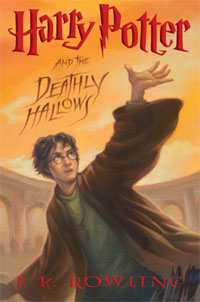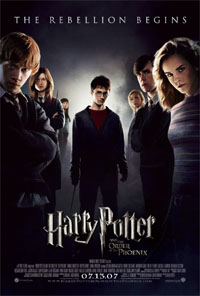 This evening I’ll be heading out with a pack of my friends to watch the fifth Harry Potter movie: Harry Potter and the Order of the Phoenix. As a certifiable geek, I have the feeling that I should be more excited about this, but that’s just not happening. For stuff that actually excites me, I’m a midnight-showing type of geek, willing to stay up into the wee hours of the morning to see the next highly-anticipated visual feast of speculative fiction. But I wouldn’t even be seeing Order of the Phoenix on opening day if it wasn’t for one of my friends putting together the plans.
This evening I’ll be heading out with a pack of my friends to watch the fifth Harry Potter movie: Harry Potter and the Order of the Phoenix. As a certifiable geek, I have the feeling that I should be more excited about this, but that’s just not happening. For stuff that actually excites me, I’m a midnight-showing type of geek, willing to stay up into the wee hours of the morning to see the next highly-anticipated visual feast of speculative fiction. But I wouldn’t even be seeing Order of the Phoenix on opening day if it wasn’t for one of my friends putting together the plans.
And the problem here isn’t Harry Potter. I’m already planning for an afternoon siesta on July 20th and am in the middle of re-reading the entire series in anticipation of picking up Harry Potter and the Deathly Hollows at a midnight release party and then devouring it before collapsing into bed late on Saturday.
The problem are the Harry Potter movies, which I have not, as a general rule, truly enjoyed. And nothing about Order of the Phoenix has raised my expectations in the slightest. Like Goblet of Fire, they are attempting to cram a rather lengthy novel into a relatively short running time. And they have hired an essentially completely unknown director whose career consists of six feature films directed over the course of nearly two decades and a handful of BBC mini-series. I’m not going to judge David Yates sight-unseen, but his resume is hardly something designed to get the blood pumping. (On the other hand, if he knocks this film out of the park then I will be anticipating Half-Blood Prince, since he’s already been contracted to direct that one.)
(And, actually, I need to slightly revise this statement: Having just checked IMDB for David Yates’ credits, I finally noticed that the author of the screenplay has changed for this film. Although IMDB claims that Steve Kloves, who adapted the first four books, will be returning for the next two, this particular film is credited to Michael Goldenberg. Goldenberg has a very short list of credits, but they include the 2003 Peter Pan and Contact, both of which were really great adaptations. So now I have at least some small glimmer of hope for this film.)
But why have I not enjoyed the previous Harry Potter films? Although their flaws have been varied, not one of these films has truly raised itself above the level of mediocrity.
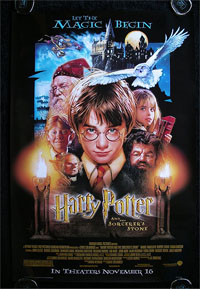 HARRY POTTER AND THE SORCERER’S STONE: Where Chris Columbus succeeded with this film was in his absolutely pitch-perfect ability to capture individual scenes, settings, and characters. The film was not only visually gorgeous, but showed such fidelity to the books that any fan could instantly pick out and appreciate their favorite scenes. The casting not only assembled an admirable cadre of child stars, but packed the film full of the most extraordinary talents imaginable while still finding the absolute perfect fits for essentially every character. The film may not always match the images my own imagination conjures forth while reading the book (such a task, of course, being impossible), but there is not a single moment where it is untrue to the book.
HARRY POTTER AND THE SORCERER’S STONE: Where Chris Columbus succeeded with this film was in his absolutely pitch-perfect ability to capture individual scenes, settings, and characters. The film was not only visually gorgeous, but showed such fidelity to the books that any fan could instantly pick out and appreciate their favorite scenes. The casting not only assembled an admirable cadre of child stars, but packed the film full of the most extraordinary talents imaginable while still finding the absolute perfect fits for essentially every character. The film may not always match the images my own imagination conjures forth while reading the book (such a task, of course, being impossible), but there is not a single moment where it is untrue to the book.
The problem, unfortunately, is that while the film captures every individual scenes with near-perfection, the individual scenes don’t necessarily tie together with the same careful, precise plotting which is one of Rowling’s primary strength as an author. As a book, Harry Potter and the Sorcerer’s Stone is a truly masterful mystery story. Harry, Hermione, and Ron are surrounded by numerous enigmas, which they attempt to unravel with the true curiosity of children through a haze of clues, red herrings, and deductions both false and true. In the end, all of these enigmas resolve themselves into a single, masterful solution.
As a movie, Harry Potter and the Sorcerer’s Stone is a collection of favorite scenes, featuring characters who stumble from one favorite scene to the next with little in the way of the connecting tissue which constitutes the actual plot. As such, it ends up being something of a visual Cliff Notes.
Now, all of that being said, I like Harry Potter and the Sorcerer’s Stone. I love the books, and watching such beautiful visual renditions of some of my favorite scenes is an enjoyable way to spend a couple of hours — much like looking through a book of Alan Lee Lord of the Rings paintings. But there is a fundamental failure here insofar as the film should be a film in its own right, not merely a visual Best Of list.
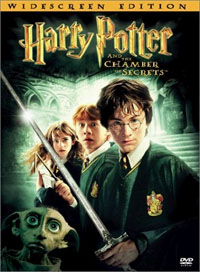 HARRY POTTER AND THE CHAMBER OF SECRETS: My opinion of Harry Potter and the Chamber of Secrets is essentially identical to my opinion of Harry Potter and the Sorcerer’s Stone. Chris Columbus brings the same strengths and weaknesses to the table for this film as he did for the first.
HARRY POTTER AND THE CHAMBER OF SECRETS: My opinion of Harry Potter and the Chamber of Secrets is essentially identical to my opinion of Harry Potter and the Sorcerer’s Stone. Chris Columbus brings the same strengths and weaknesses to the table for this film as he did for the first.
In some ways, though, watching Chamber of Secrets is more frustrating for me because, in this case, they came so agonizingly close to restoring those ligaments of the plot which were missing. To take one isolated example, the film actually shows Hagrid holding a dead rooster. Later there is a completely bungled piece of editing in which an insert shot focuses on the rooster-hating properties of basilisks, but then has Harry repeat the same piece of information he had mentioned less than a minute before. An extra thirty seconds of film (which was almost certainly shot) could have fundamentally restored that most important property of mystery stories: The weaving together of multiple clues to reach a singular conclusion.
Chamber of Secrets also has another key bungle: When Harry first hears the murderous voice of the basilisk in the film, the first thing he does is press his ear up against the wall to hear it more clearly. In the book, the realization that Harry is not hearing a disembodied voice, but rather a voice traveling through the walls, is one of the key insights which allows Hermione to solve the mystery. By ham-handedly revealing this piece of information almost instantaneously, the film not only disrupts its own narrative structure, but removes some of the mystery surrounding the voice.
On the other hand, the film does make one significant alteration which fixes what I consider to be a bungling by Rowling herself.
When I first read the books, Chamber of Secrets was probably my least favorite of the series. This was in large part due to what I considered the entirely unsatisfactory nature of the book’s conclusion, which goes something like this:
–Harry, bitten by the basilisk in its death throes, is dying from its poison.
TOM RIDDLE: Ha, ha! You’re dying Harry! I shall stand hear and gloat! Even your phoenix is crying for you!
–The phoenix’s tears heal Harry’s wound.
TOM RIDDLE: Oh yeah, phoenix tears heal wounds. I’ve suddenly gone from being a cunning villain to being an ignorant prat. Well, allow me to monologue some more about how doomed you are, Harry Potter! You are doomed! Doomed! Doom– Hey, what are you doing?
–Harry stabs the diary. Tom Riddle dies.
There is a game called Before I Kill Your, Mister Bond… which makes fun of the propensity for Bond villains to monologue about their evil plans just long enough for James Bond to escape and destroy them. If you’ve seen the first Austin Powers movie, you’ll see the same joke.
Now, villainous monologuing can certainly work if its handled properly. Rowling herself does a masterful job of it when Voldemort returns in Goblet of Fire: Voldemort not only needs to destroy Harry, he needs his followers to see him destroy and ridicule Harry. He’s trying to eliminate any doubt that Harry was ever a true threat to him, and re-establish the fear and awe which are the foundations of his power. The plan, of course, backfires when Harry survives. But the result is a strongly-motivated and powerful scene.
The problem in Chamber of Secrets is that Tom Riddle never stops monologuing. His first session of monologuing, which actually takes place before the basilisk fight, makes sense: He’s revealing his true nature to Harry, but he’s doing it because he wants to understand how Harry was responsible for Voldemort’s destruction (so that he can avoid repeating the same mistakes). Once he’s got that information, he immediately unleashes the basilisk to kill Harry. (Which, if we assume Tom Riddle does not yet know the killing-curse, is probably the quickest and most expedient way of killing Harry.)
But after the basilisk fight, Tom Riddle returns to his villainous monologuing not once, but twice.
VILLAIN: Before I kill you, Mr. Bond, allow me to explain my entire nefarious scheme for conquering–
–James Bond escapes and destroys half of the villain’s base before being recaptured.
VILLAIN: Now that I have recaptured you, Mr. Bond, allow me to explain my entire nefarious scheme for conquering–
–James Bond escapes again and destroys the other half of the villain’s base.
The problem is that it makes Tom Riddle look like a complete schmuck. And, since he forgets a basic property of phoenix tears, it makes him look like a stupid and completely ineffectual schmuck.
Long story short (too late), it makes for an entirely unsatisfactory conclusion to the book. (Particularly with the deus ex machina of Fawkes, the Sorting Hat, and Gryffindor’s sword.) And, in combination with the relative ease with which Voldemort was dispatched in the first book, did much to reduce Riddle’s status as a Dark Lord. (He came across as the type of “Dark Lord” that actual Dark Lords like to make fun of.) It’s to Rowling’s credit that she has thoroughly managed to rehabilitate him over the course of the subsequent books.
Which brings me, ultimately, back to the film which does a brilliant job of fixing this sequence. In the film we get:
–Harry, bitten by the basilisk in its death throes, is dying from its poison.
TOM RIDDLE: Ha, ha! You’re dying Harry! I shall stand hear and gloat!
–As a final, valiant act, Harry stabs the diary and Tom Riddle dies.
–Ginny wakes up and Harry, in a heart-touching moment, tries to get her to leave him so that she doesn’t watch him die.
–The phoenix flies to Harry and her tears heal Harry’s wound.
Brilliant. Tom Riddle gloating over a helpless and dying Harry is perfectly in keeping with his character. Simply failing to anticipate Harry using the basilisk fang as a weapon against the diary is a very different and much more acceptable type of error compared to Riddle literally providing the exposition of his own stupidity when it comes to the healing properties of phoenix tears. And, on top of that, you get a truly brilliant, albeit brief, scene between Harry and Ginny.
So, on the strength of that correction, I think I shall say that I prefer Chamber of Secrets to Sorcerer’s Stone, although it’s a close thing.
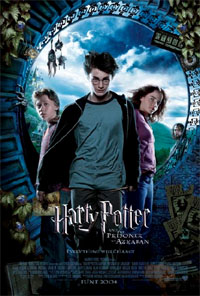 HARRY POTTER AND THE PRISONER OF AZKABAN: The third Harry Potter film was, of course, a departure from the previous two, featuring the talents of Alfonso Cuarón (more lately of Children of Men fame). This is, in my opinion, the strongest of the Harry Potter films to date because, in short, it is the only film which actually succeeds as a film. Most notably it features a plot with not only a true beginning, middle, and end, but with the complications and rich texturing which make a plot something more than simply “A happens and then B happens and then C happens”.
HARRY POTTER AND THE PRISONER OF AZKABAN: The third Harry Potter film was, of course, a departure from the previous two, featuring the talents of Alfonso Cuarón (more lately of Children of Men fame). This is, in my opinion, the strongest of the Harry Potter films to date because, in short, it is the only film which actually succeeds as a film. Most notably it features a plot with not only a true beginning, middle, and end, but with the complications and rich texturing which make a plot something more than simply “A happens and then B happens and then C happens”.
On the other hand, Prisoner of Azkaban fails to evoke the same visual beauty and fidelity of the first two films. Instead of capturing the heart of Rowling’s work, Cuarón brought his own sensibilities to the tale. This is not necessarily the worst thing for a director to do when adapting a book to the screen, but in an ideal world I would prefer to see Columbus’ ability to capture the spirit of Rowling’s work paired with Azkaban’s willingness to restructure the plot in order to make the story truly work on the big screen.
I’m also faced with minor frustrations in Prisoner of Azkaban, much like I was in Chamber of Secrets, in places where I can see that spending an extra 30 seconds could have much improved the structure of the film. The thing that stands out most clearly in my mind is the failure to explain the meaning of “Moony, Padfoot, Prongs, and Wormtail”. Less than 30 seconds of dialogue explaining that could have tied together the Marauder’s Map, revealed important elements of the backstory (not only for this film, but for later films), and explained the significance of Harry’s patronus.
On the balance, I enjoy Prisoner of Azkaban, though. As I said, it’s probably my favorite of the films to date. So why do I still describe it as, ultimately, a mediocrity? Well, simply compare it to Cuarón’s Children of Men or The Fellowship of the Rings. It’s an enjoyable film, but if it wasn’t a Harry Potter film we would scarcely remember it at three years distance.
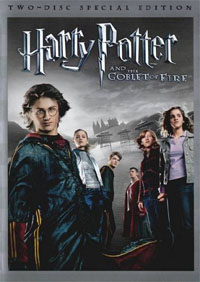 HARRY POTTER AND THE GOBLET OF FIRE: This film is a complete disaster.
HARRY POTTER AND THE GOBLET OF FIRE: This film is a complete disaster.
Harry Potter and the Goblet of Fire is actually one of my motivations for writing out this lengthy essay. I saw the film once in the theater and was completely turned off by its complete, utter, and unmitigated failure: It failed as an adaptation. It failed as a film. It failed as entertainment. It just… failed.
Nonetheless, driven by my completist collectorism, I ended up picking up a cheap used copy at Blockbuster a couple of months ago. Last night, in anticipation of Order of the Phoenix, I decided to rewatch it. I only got halfway through it before shutting off the DVD player, and I had only endured that long because there was some intellectual curiosity to be satisfied in picking apart the film’s many failings. It’s been a long time since I was subjected to such utter drek.
Even more than the first two films, Goblet of Fire assumes that you have already read the books. The film is essentially gobbledygook to anyone who doesn’t already know what’s going on.
For example, early in the film the director pans across a large field and ends on a lingering glory short of a moldy old boot while the music crescendos in a cascade of awe. The shot is completely meaningless unless you’ve read the book and already know that the boot is a portkey (and, even then, the awe in which this particular portkey is held is bizarrely inexplicable). A little later, after building up to the Quidditch World Cup, the film inexplicably skips the entire match in a jarring jump-cut.
These are just two small examples, but the entire film is done in essentially the same manner: The director shouts, “REMEMBER THIS BIT? DO YOU? DO YOU?! DO YOU?!?!” And then jump-cuts to the next bit.
Nor can one simply enjoy the film as an eclectic collection of the Best Bits From the Book because the film is filled with endless and pointless alterations. Now, I’m not a purist about such things. As the rest of this essay suggests, I actually want a film to make changes to the material it’s adapting so that it can become an effective film in its own right. (As another example, I thought Jackson’s handling of Arwen in The Fellowship of the Ring was a masterful example of how to handle an insightful, yet faithful, adaptation.)
But if you’re going to change something, there had better be a reason for changing it. In other words, the change should make for a better film than if you hadn’t made the change. If it doesn’t, why are you making the change?
Perhaps the most inexplicable change in Goblet of Fire is the constant rewriting of the dialogue. Rowling’s dialogue is repeatedly replaced with trite, banal, cliche-ridden filler. And even when Rowling’s words are preserved, they are often shuffled in a seemingly random fashion until they’ve been rendered into utter nonsense.
For example, there’s a point where Professor Moody says to Neville that “Professor Sprout tells me your quite good at Herbology”. In the book, Moody is saying this specifically to reassure Neville after has been shaken by seeing the cruciatus curse in class. In the movie, however, this line of dialogue is nonsensically and jarringly moved to a much earlier point in the conversation, before the curse has even been performed. As a result, it serves no purpose at all — its just Moody saying something completely at random.
And the film’s failure as an adaptation only scratches the surface here. The director, Mike Newell, is a complete hack in this film. (Which I found surprising, given how much I enjoyed his work on Donnie Brasco.) The camera spins and twirls and rushes about with wild abandon, but it never seems to find a compelling visual frame. And every so often, Newell will pan quite randomly off the main action in order to show us a secondary character sitting or standing nearby… doing absolutely nothing and, frequently, barely reacting to what’s happening. Newell particularly likes to end scenes this way, which only contributes to the herky-jerky feeling of the film, with scene after scene ending on an awkward and inexplicable visual note.
HARRY POTTER AND THE ORDER OF THE PHOENIX: So, when it comes to Harry Potter and the Order of the Phoenix, my hopes are not high. None of the films have truly excelled, and Goblet of Fire — with which Order of the Phoenix has the most in common (long book to short film, unproven director, and so forth) — was a complete train wreck.
But, ultimately, I’ve got my fingers crossed. Because, like I say, if I enjoy Order of the Phoenix there’s a strong chance that Half-Blood Prince will be good, as well. On the other hand, if Order of the Phoenix is a disaster, there’s little chance that I’ll see Half-Blood Prince at all.
Go to My Review of Harry Potter and the Order of the Phoenix

